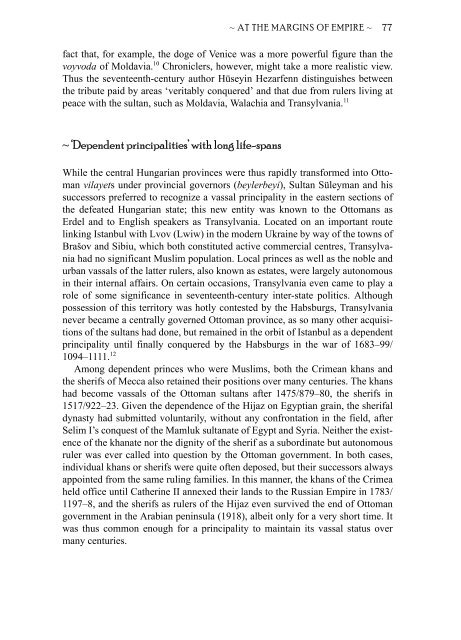The Ottoman Empire and the World Around It - Course Information
The Ottoman Empire and the World Around It - Course Information
The Ottoman Empire and the World Around It - Course Information
You also want an ePaper? Increase the reach of your titles
YUMPU automatically turns print PDFs into web optimized ePapers that Google loves.
~ AT THE MARGINS OF EMPIRE ~ 77<br />
fact that, for example, <strong>the</strong> doge of Venice was a more powerful figure than <strong>the</strong><br />
voyvoda of Moldavia. 10 Chroniclers, however, might take a more realistic view.<br />
Thus <strong>the</strong> seventeenth-century author Hüseyin Hezarfenn distinguishes between<br />
<strong>the</strong> tribute paid by areas ‘veritably conquered’ <strong>and</strong> that due from rulers living at<br />
peace with <strong>the</strong> sultan, such as Moldavia, Walachia <strong>and</strong> Transylvania. 11<br />
~ ‘Dependent principalities’ with long life-spans<br />
While <strong>the</strong> central Hungarian provinces were thus rapidly transformed into <strong>Ottoman</strong><br />
vilayets under provincial governors (beylerbeyi), Sultan Süleyman <strong>and</strong> his<br />
successors preferred to recognize a vassal principality in <strong>the</strong> eastern sections of<br />
<strong>the</strong> defeated Hungarian state; this new entity was known to <strong>the</strong> <strong>Ottoman</strong>s as<br />
Erdel <strong>and</strong> to English speakers as Transylvania. Located on an important route<br />
linking Istanbul with Lvov (Lwiw) in <strong>the</strong> modern Ukraine by way of <strong>the</strong> towns of<br />
Brašov <strong>and</strong> Sibiu, which both constituted active commercial centres, Transylvania<br />
had no significant Muslim population. Local princes as well as <strong>the</strong> noble <strong>and</strong><br />
urban vassals of <strong>the</strong> latter rulers, also known as estates, were largely autonomous<br />
in <strong>the</strong>ir internal affairs. On certain occasions, Transylvania even came to play a<br />
role of some significance in seventeenth-century inter-state politics. Although<br />
possession of this territory was hotly contested by <strong>the</strong> Habsburgs, Transylvania<br />
never became a centrally governed <strong>Ottoman</strong> province, as so many o<strong>the</strong>r acquisitions<br />
of <strong>the</strong> sultans had done, but remained in <strong>the</strong> orbit of Istanbul as a dependent<br />
principality until finally conquered by <strong>the</strong> Habsburgs in <strong>the</strong> war of 1683–99/<br />
1094–1111. 12<br />
Among dependent princes who were Muslims, both <strong>the</strong> Crimean khans <strong>and</strong><br />
<strong>the</strong> sherifs of Mecca also retained <strong>the</strong>ir positions over many centuries. <strong>The</strong> khans<br />
had become vassals of <strong>the</strong> <strong>Ottoman</strong> sultans after 1475/879–80, <strong>the</strong> sherifs in<br />
1517/922–23. Given <strong>the</strong> dependence of <strong>the</strong> Hijaz on Egyptian grain, <strong>the</strong> sherifal<br />
dynasty had submitted voluntarily, without any confrontation in <strong>the</strong> field, after<br />
Selim I’s conquest of <strong>the</strong> Mamluk sultanate of Egypt <strong>and</strong> Syria. Nei<strong>the</strong>r <strong>the</strong> existence<br />
of <strong>the</strong> khanate nor <strong>the</strong> dignity of <strong>the</strong> sherif as a subordinate but autonomous<br />
ruler was ever called into question by <strong>the</strong> <strong>Ottoman</strong> government. In both cases,<br />
individual khans or sherifs were quite often deposed, but <strong>the</strong>ir successors always<br />
appointed from <strong>the</strong> same ruling families. In this manner, <strong>the</strong> khans of <strong>the</strong> Crimea<br />
held office until Ca<strong>the</strong>rine II annexed <strong>the</strong>ir l<strong>and</strong>s to <strong>the</strong> Russian <strong>Empire</strong> in 1783/<br />
1197–8, <strong>and</strong> <strong>the</strong> sherifs as rulers of <strong>the</strong> Hijaz even survived <strong>the</strong> end of <strong>Ottoman</strong><br />
government in <strong>the</strong> Arabian peninsula (1918), albeit only for a very short time. <strong>It</strong><br />
was thus common enough for a principality to maintain its vassal status over<br />
many centuries.


